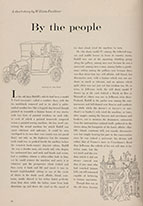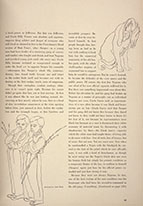Magazine Illustrations
| CLOSE WINDOW |

|
The first visualizations of Faulkner's Yoknapatawpha fictions were the illustrations drawn to accompany the publication of his short stories in magazines like The Saturday Evening Post, Scribner's and Collier's, the large circulation periodicals that Faulkner regularly submitted work to in his quest for income. Although Faulkner occasionally worked directly with the magazines' editors to revise a story, there is no evidence that he had any control over - or even interest in - the way these magazines illustrated his texts. The illustrations can, however, help us appreciate the way Faulkner's world, and the people of different races and classes who inhabit it, appeared to his original readers. The following items are drawn from the William Faulkner Foundation Collection at the University of Virginia's Albert and Shirley Small Special Collections Library (http://small.library.virginia.edu/). The seven drawings by Jean Watts that appeared along with the story in the October 1955 issue of Mademoiselle emphasize the humorous, perhaps even the cartoonish aspects of Faulkner's tall tale. Huey Long, the Southern demagogue mentioned in the story, had been dead for two decades in 1955, but in the immediate aftermath of the McCarthy Era a different artist might have chosen to indicate the story's more serious political implications. Even Watts' Ku Klux Klan regalia, however, and the policeman who has drawn his weapon seem as unthreatening as Watts' hound. (In a few more years, of course, after the Civil Rights Movement begins, it would have been impossible to depict Southern policemen and dogs, not to mention Southern demagogues and the KKK, so blandly.)     Citing this source:
|
